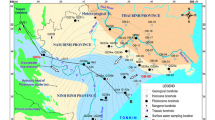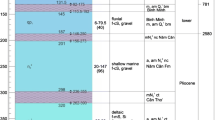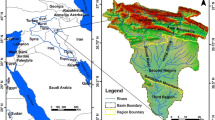Abstract
Major ions and important trace elements in addition to δ18O and δ2H were analysed for 43 groundwater samples sampled from the Al-Batin alluvial fan aquifer, South Iraq. The most dominant ions (with respect to molarity) were: Na+ > Cl− > SO4 2− > Ca2+ > Mg2+ > NO3 − > HCO3 −, with total dissolved solids (TDS) averaging 7855 mg/L. High concentrations were found for the trace elements U, Mo, V, B, Sr, and Cr. This study suggests a hydraulic connection exists near the fan apex between the uppermost part of the Al-Batin aquifer and the underlying Dammam aquifer by means of the Abu-Jir fault system. Except for the effects of extensive irrigation, fertilizer use, and poorly maintained sewers, the groundwater chemistry is mainly controlled by geological processes such as dissolution of evaporites and the enrichment of dissolved ions as a result of the high evaporation and low recharge rate. Furthermore, it is shown that the Kuwaiti fuel–oil burning during Gulf War in 1991 contributed to the enrichment of V and Mo in the studied aquifer. The spatial distribution of most ions appears to generally increase from the south-west towards the north-east, in the direction of groundwater flow. The stable isotopes show heavier values in groundwater with a gradually increasing trend in the direction of groundwater flow due to the decreasing depth to groundwater and thus increasing of evaporation from both groundwater or irrigation return water. Additionally, the stable isotope signature suggests that rainfall from sources in the Arabian Gulf and the Arabian Sea is the major source of recharge for the Al-Batin aquifer. Except for two samples of groundwater, all samples were not suitable for potable use according to the WHO standards. Most of the groundwater is suitable for some agricultural purpose and for livestock water supply. Apart from the high salinity, boron represents the most critical element in the groundwater with respect to agricultural purposes.










Similar content being viewed by others
References
Abdullah H (2015) Environmental assessment of Al-Hammar Marsh, Southern Iraq. PhD thesis, University of Baghdad (unpublished)
Afaj A, Schüth Ch, Kallioras A, Hassan H, Thejeel S (2015) Spatial variation of boron in groundwater in South Iraq. Int J Environ Stud 72:4. doi:10.1080/00207233.2015.1037223
Ahmed Z, Hariri M (2008) Neoproterozoic ophiolites as developed in Saudi Arabia and their oceanic and pericontinental domains. Arab J Sci Eng 33(1):17–54
Al-Abadi A, Shahid S (2016) Spatial mapping of artesian zone at Iraqi southern desert using a GIS-based random forest machine learning model. Model Earth Syst Environ 2(96):1–17. doi:10.1007/s40808-016-0150-6
Al-Aboodi A, Al-Tai M, Al-Khadhimi A (2008) Hydrochemical classification of groundwater in Safwan–Al-Zubair Area, South of Iraq. Marsh Bull 3(1):45–56
Al-Basrawi N (2009) Hydrogeology and hydrochemistry of Al-Basrah governorate. Iraq-GEOSURV, Int. Rep. No. 1345 (unpublished)
Al-Bassam K (2011) Petrology and chemistry of some exotic rock fragments from Jabal Sanam, Basrah, Iraq. Iraqi Bull Geol Min 7(1):39–53
Al-Habeeb N, Al-Shammary Th (2015) Petrography and mineralogy of the Dammam formation in Al-Najaf Governorate. Iraq J Sci 56(3A):2024–2037
Al-Hmedawy H (2008) Geomorphological Study of Haur Al-Hammar and adjacent area Southern Iraq using remote sensing data and GIS techniques. PhD thesis, University of Baghdad (unpublished)
Al-Kubaisi Q (1999) Quaternary-Tertiary hydrogeologic boundary condition at safwan-zubair area. South of Iraq. Iraq Jour Sci 40(3):21–28
Al-Naqib K (1970) Geology of jabal sanam, south Iraq. J Geol Soc Iraq 3(1):9–36
Ali K, Al-Kubaisi Q, Al-Paruany K (2015) Isotopic study of water resources in a semi-arid region, western Iraq. Environ Earth Sci 74:1671–1686. doi:10.1007/s12665-015-4172-6
Al-Jiburi H, Al-Basrawi N (2009) Geology of Iraqi Southern Desert, hydrogeology. Iraqi Bull Geol Min Special Issue 2:77–91
Alkinani M, Kanoua W, Merkel B (2016) Uranium in groundwater of the Al-Batin alluvial fan aquifer, South Iraq. Environ Earth Sci 75:869. doi:10.1007/s12665-016-5685-3
Al-Malack M, Bukhari A, Al-Amoudi O, Al-Muhanna H, Zaidi T (2013) Characteristics of fly ash produced at power and water desalination plants firing fuel oil. Int J Environ Res 7(2):455–466
Al-Marsoumi A, Dawood T, Al-Khait N (2004) Evolution and origin of sabkha soils and their geomorphic features west of Shatt Al-Arab Basra Area- Southern Iraq. Basra J Agric Sci 17(1):26–41
Al-Mashaikhi K (2011) Evaluation of groundwater recharge in Najd aquifers using hydraulics, hydrochemical and isotope evidences. PhD thesis, Friedrich-Schiller-Universität Jena
Al-Muslih S (2012) Hydrogeological and hydrochemical study of Al-Basra quadrangle (NH-38-8) and Abadan quadrangle (NH-39-5) scale 1:250000. Iraq-GEOSURV, int. rep. no. 3402 (unpublished)
Al-Sharbati F, Ma’ala K (1983) Report on the regional geological mapping of west of Zubair area. Iraq-GEOSURV, int. rep. no. 1345 (unpublished)
Al-Sulaimi J, Viswanathan MN, Székely F (1993) Effect of oil pollution on fresh groundwater in Kuwait. Environ Geol 22:246–256
Al-Tememi M (2015) Groundwater quality and origin within Dibdibba aquifer near Jabel Sanam area southern of Basra Governorate, Iraq. Mesopot J Mar Sci 30(1):47–56
Atiaa A, Al-Asadiy S (2007) Management of groundwater resource of Dibdibba Sandy Aquifer in Safwan-Zubair area, South of Iraq. J College Arts 42:30–49
ATSDR (2012) Toxicological profile for vanadium. U.S. Department of Health and Human Services, Public Health Service, Agency for Toxic Substances and Disease Registry, Atlanta
Basher W, Al-Samarraie B, Al-Dulaimy R (2015) Petrography and biostratigraphy of Eocene rocks in South Samawa Area, Southern Iraq. Iraqi Bull Geol Min 11(3):19–38
Boumans J, van Hoorn J, Kruseman G, Tanwar B (1988) Water table control, reuse and disposal of drainage water in Haryana. Agric Water Manag 14:537–545
Butterwick N, Oude D, Raymond K (1989) Safety assessment of boron in aquatic and terrestrial environments. Ecotoxicol Environ Saf 17:339–371. doi:10.1016/0147-6513(89)90055-9
Cagatay M (1990) Palygorskite in the Eocene rocks of the Dammam Dome, Saudi Arabia. Clays Clay Miner 38(3):299–307
Capo R, Stewart B, Chadwick O (1998) Strontium isotopes as tracers of earth surface processes: theory and methods. Geoderma 82:197–225. doi:10.1016/S0016-7061(97)00102-X
Carlisle D (1983) Concentration of uranium and vanadium in calcretes and gypcretes. Geol Soc 111:185–195. doi:10.1144/GSL.SP.1983.011.01.19
CCME (1999) Canadian Environmental Quality Guidelines. Canadian Council of Ministers of the Environment. P N 1299, ISBN 1-896997-34-1
Craig H (1961) Isotopic variations in meteoric waters. Science 133(3465):1702–1703. doi:10.1126/science.133.3465.1702
Davis W, Middaugh D (1978) A review of the impact of chlorination process upon marine ecosystems. In: Jolley RL (ed) Water chlorination: environmental impact and health effects, vol I. Ann Arbor Science Publishers, Inc., Ann Arbor, pp 283–310
Davis S, Whittemore D, Fabryka-Martin J (1998) Uses of chloride/bromide ratios in studies of potable water. Ground Water 36(2):338–350. doi:10.1111/j.1745-6584.1998.tb01099.x
Eisler R (1989) Molybdenum hazards to fish, wildlife, and invertebrates: a synoptic review. U.S. Fish Wildl Serv Biol Rep 85(1.19):1–43
Elisante E, Muzuka A (2016) Assessment of sources and transformation of nitrate in groundwater on the slopes of Mount Meru, Tanzania. Environ Earth Sci 75(3):1–17. doi:10.1007/s12665-015-5015-1
EPA (1988) Water quality standards criteria summaries: a compilation of state/federal criteria. Environmental Protection Agency (EPA), Office of Water, EPA/440/5-88/011
EPA (2012) Guidelines for water reuse. Environmental Protection Agency (EPA), office of wastewater management, EPA/600/R-12/618
Erickson J (1980) Using high salinity waters in the Southwest. In: Specialty conference on irrigation and drainage, today’s challenges, Boise, Idaho. ASCE, New York, pp 198–204
FAO (1985) FAO irrigation and drainage paper, 29 Rev. 1. Food and Agriculture Organization of the United Nations, Rome
Fouad S (2012) Tectonic map of Iraq, scale 1: 1000 000, 3rd Edition, 2012. Iraqi Bull Geol Min 11(1):1–7
Gat J, Klein B, Kushnir Y, Roether W, Wernli H, Yam R, Shemesh A (2003) Isotope composition of air moisture over the Mediterranean Sea: an index of the air–sea interaction pattern. Tellus 55(B):953–965
Gay J, Shepard O, Thyden M, Whitman M (2010) The health effects of oil contamination: a compilation of research. http://www.wpi.edu/Pubs/E-project/Available/E-project-121510-203112/unrestricted/Health_Effects_of_Oil_Contamination_-_Final_Report.pdf
Goldberg S, Forster H, Godfrey C (1996a) Molybdenum adsorption on oxides, clay minerals, and soils. Soil Sci Soc Am J 60:425–432. doi:10.2136/sssaj1996.03615995006000020013x
Goldberg S, Forster H, Lesch S, Heick E (1996b) Influence of anion competition on boron adsorption by clays and soils. Soil Sci 161(2):99–103
Gupta C, Krishnamurthy N (1992) Extractive Metallurgy of Vanadium (Process Metallurgy 8). Elsevier, ISBN 0-0444-88252-9, p 689
Hadi K, Kumar US, Al-Senafy M, Bhandary H (2016) Environmental isotope systematics of the groundwater system of southern Kuwait. Environ Earth Sci 75:1096. doi:10.1007/s12665-016-5886-9
Hassan K, Al-Khateeb A (2006) Distribution of celestite in Karbala—Najaf area, Central Southern part of Iraq. Iraqi Bull Geol Min 2(1):45–56
Hassan K, Alkinani M (2002) Exploration new localities of celestite, feldspar and attapulgite deposits’ in Karbala—Tar Al-Said area. Iraqi-GEOSURV international report no. 2819 (unpublished)
Hayes J (2004) An introduction to isotopic calculations. Woods Hole Oceanographic Institution, Woods Hole. https://www.scribd.com/doc/311565179/Isotopic-Calculations-pdf
Head P, Burton J (1970) Molybdenum in some ocean and estuarine waters. J Mar Biol Assoc United Kingdom 50:439–448. doi:10.1017/S002531540000463X
Hem J (1989) Study and interpretation of the chemical characteristics of natural water. In: United State Geological Survey Water-Supply Paper, 2254 3rd edn. US Government Printing Office, Washington, DC
Jassim R, Al-Jiburi B (2009) Geology of Iraqi Southern Desert, stratigraphy. Iraqi Bull Geol Min Special Issue 2:53–76
Jassim S, Goff J (2006) Geology of Iraq. Dolin and Moravian Museum, Prague
Jassim S, Karim S, Basi M, Al-Mubarak M, Munir J (1984) Final report on the regional geological survey of Iraq, Stratigraphy. GEOSURV, international report no. 1447 (unpublished)
Kim K, Yun S (2005) Buffering of sodium concentration by cation exchange in the groundwater system of a sandy aquifer. Geochem J 39:273–284
Kuiper N, Rowell C, Shomar B (2015) High levels of molybdenum in Qatar’s groundwater and potential impacts. J Geochem Explor 150:16–24
Larsson M (2014) Vanadium in soils chemistry and ecotoxicity. Doctoral Thesis, Swedish University of Agricultural Sciences. ISBN 978-91-576-8153-9
Levins I, Gosk E (2008) Trace elements in groundwater as indicators of anthropogenic impact. Environ Geol 55:285–290. doi:10.1007/s00254-007-1003-4
Leybourne M, Cameron E (2008) Source, transport, and fate of rhenium, selenium, molybdenum, arsenic, and copper in groundwater associated with porphyry–Cu deposits, Atacama Desert, Chile. Chem Geol 247:208–228
Magaritz M, Nadler A, Koyumdjisky H, Dan J (1981) The use of Na/Cl ratios to trace solute sources in a semiarid zone. Water Resour Res 17(3):602–608. doi:10.1029/WR017i003p00602
Manhi H (2012) Groundwater contamination study of the upper part of the Dibdibba aquifer in Safwan area, southern Iraq. PhD thesis, University of Baghdad (unpublished)
Mashali A (1985) Amelioration and development of deteriorated soils-Egypt. Technical report, Project FAO/UNDP EGY/79/020, Cairo, Egypt, 1984–1985
Merkel B, Planer-Friedrich B (2008) Groundwater geochemistry, a practical guide to modeling of natural and contaminated aquatic systems, 2nd edn. Springer, Berlin
Moss S, Nagpal N (2003) Ambient water quality guidelines for boron. National Library of Canada Cataloguing in Publication Data. ISBN 0-7726-5048-9
Moujabber M, Bou Samra B, Darwish T, Atallah T (2006) Comparison of different indicators for groundwater contamination by seawater intrusion on the Lebanese Coast. Water Resour Manag 20:161–180. doi:10.1007/s11269-006-7376-4
Mullaney J, Lorenz D, Arntson A (2009) Chloride in groundwater and surface water in areas underlain by the glacial aquifer system, Northern United States. U.S. Geological Survey, Reston
Oroz L, Bellomo S, D’alessandro W (2014) High vanadium concentrations in groundwater at El Hierro (Canary Islands, Spain). In: 10th international hydrogeological congress of Greece/Thessaloniki
Oze C, Bird D, Fendorf S (2007) Genesis of hexavalent chromium from natural sources in soil and groundwater. PNAS 104:6544–6549. doi:10.1073/pnas.0701085104
Parkhurst D, Appelo C (1999) User’s guide to PHREEQC (version 2) a computer program for speciation, batch-reaction, one-dimensional transport, and inverse geochemical calculations. Report 99–4259, Denver, Colorado
Peters A (2011) Copper deficiency in beef cattle: pasture-applied copper study in coos county. Oregon State University, Oregon
Phocaides A (2000) Technical handbook on pressurized irrigation techniques. Food and Agriculture Organization of the United Nations (FAO), Rome
Powers R, Ramirez L, Redmond C, Elberg E (1985) Geology of the Arabian Peninsula Sedimentary Geology of Saudi Arabia. U.S. Geological Survey Professional Paper 560-D
Ragunath H (1987) Ground water, 2nd edn. Wiley Eastern Ltd, New Delhi
Rao S, Reddy G, Nagamani M, Vidyasagar G, Satyanarayana N (2012) Chemical characteristics of groundwater and assessment of groundwater quality in Varaha River Basin, Visakhapatnam District, Andhra Pradesh, India. Environ Monit Assess 184:5189–5214. doi:10.1007/s10661-011-2333-y
Ravenscroft P, McArthur J (2004) Mechanisms of regional enrichment of groundwater by boron: the examples of Bangladesh and Michigan, USA. Appl. Geochem 19:1413–1430. doi:10.1016/j.apgeochem.2003.10.014
Richards L (1954) Diagnosis and improvement of saline and alkali soils. USDA agriculture handbook 60, Washington DC
Sadashivaiah C, Ramakrishnaiah CR, Ranganna G (2008) Hydrochemical analysis and evaluation of groundwater quality in Tumkur Taluk, Karnataka State, India. Int J Environ Res Public Health 5(3):158–164. doi:10.3390/ijerph5030158
Sadiq M, Mian A (1994) Nickel and vanadium in air particulates at Dhahran (Saudi Arabia) during and after the Kuwait oil fires. Atmos Environ 28(13):2249–2253
Sadooni F, Alsa’ad H, Nasir S (2004) Halul and Sharao islands offshore Qatar remnants of great Infracambrian Hormuz Salt Basin. Carbonates Evaporites 19:17–27
Saha D, Singh B, Srivastava S, Dwivedi S, Mukherjee R (2014) Concept note on geogenic contamination of ground water in India (with a special note on Nitrate). Central Ground Water Board (CGWB), Bujal Bhawan, NH-IV, Faridabad, Haryana
Shadfan H, Mashhady A, Dixon J, Hossen A (1985) Palygorskite from tertiary formations of Eastern Saudi Arabia. Clays Clay Miner 33(5):451–457
Sissakian V, Shihab A, Al-Ansari N, Knutsson S (2014) Al-Batin alluvial fan, southern Iraq. Engineering 6:699–711
Smedley P, Cooper D, Ander E, Milne C, Lapworth D (2014) Occurrence of molybdenum in British surface water and groundwater: distributions, controls and implication for water supply. Appl Geochem 40:144–154. doi:10.1016/j.apgeochem.2013.03.014
Smith C (1991) Proposed method of hydrogeochemical exploration for salt deposits using CI–Br ratios, Eastern Province, Kingdom of Saudi Arabia. Appl Geochem 6:249–255
Soltan B, Al-Fregi A, Abdul-Naby Z (2007) Petrogenesis of sedimentary ironstones in Jabal Sanam structure Southern Iraq. Marina Mesop 22(1):93–105
Srinivas Y, Hudson Oliver D, Stanley Raj A, Chandrasekar N (2013) Evaluation of groundwater quality in and around Nagercoil town, Tamil Nadu, India: an integrated geochemical and GIS approach. Appl Water Sci 3:631–651
Stas J, Dahdouh A, Al-chayah O (2007) Recovery of vanadium, nickel and molybdenum from fly ash of heavy oil-fired electrical power station. Chem Eng 51(2):67–70. doi:10.3311/pp.ch.2007-2.11
Su C, Wang Y, Pan Y (2013) Hydrogeochemical and isotopic evidences of the groundwater regime in Datong Basin, Northern China. Environ Earth Sci 70:877–885. doi:10.1007/s12665-012-2176-z
Tamar-Agha M, Saleh S (2016) Facies analysis and depositional environment of the Rus and Jil formations (l-Eocene) in Najaf and Samawa Areas, Southern Iraq. Journal of Environment and Earth Science 6(4):30–39
Thimonier A, Schmitt M, Waldner P, Schleppi P (2008) Seasonality of the Na/Cl ratio in precipitation and implications of canopy leaching in validating chemical analyses of throughfall samples. Atmos Environ 42:9106–9117. doi:10.1016/j.atmosenv.2008.09.007
Todd DK (1980) Groundwater hydrology, 2nd edn. Wiley, New York, p 535
Tredoux G, Engelbrecht P, Israel S (2009) Nitrate in groundwater: why is it a hazard and how to control it, Water Research Commission Report No.TT 410/09. Republic of South of Africa
Van Hoorn J (1971) Quality of irrigation water limits of use and prediction of long-term effects. In: Salinity seminar, Baghdad. Irrigation and Drainage, FAO, Rome. Paper 7, pp 117–135
Vengosh A, Rosenthal E (1994) Saline groundwater in Israel: its bearing on the water crisis in the country. J Hydrol 156:389–430. doi:10.1016/0022-1694(94)90087-6
WHO (2003a) Boron in drinking-water, background document for development of WHO guidelines for drinking-water quality. World Health Organization, Geneva
WHO (2003b) Chromium in drinking-water, background document for development of WHO guidelines for drinking-water quality. World Health Organization, Geneva
WHO (2011) Guidelines for drinking water quality, 4th edn. World Health Organization, Geneva
Wilcox L (1955) Classification and use of irrigation waters. US Department of Agriculture, Arc 969, Washington DC
Wright M, Belitz K (2014) Factors controlling the regional distribution of vanadium in groundwater. Ground Water 48(4):515–525. doi:10.1111/j.1745-6584.2009.00666.x
Wright M, Stollenwerk K, Belitz K (2014) Assessing the solubility controls on vanadium in groundwater, northeastern San Joaquin Valley, CA. Appl Geochem 48:41–52. doi:10.1016/j.apgeochem.2014.06.025
Wright M, Fram M, Belitz K (2015) Geochemical conditions and the occurrence of selected trace elements in groundwater basins used for public drinking-water supply, desert and basin and range hydrogeologic provinces, 2006–11: California GAMA Priority Basin Project. Geological Survey Scientific Investigations Report 2014-5173. doi:10.3133/sir20145173
Yacoub S (2011) Stratigraphy of the Mesopotamia Plain. Iraqi Bull Geol Min Special Issue Geol Mesop Plain 4:47–82
Acknowledgements
This work was financially supported by the Iraq Geological Survey (GEOSURV-IRAQ) and the Iraqi Ministry of Higher Education and Scientific Research. Many thanks to Talal H. Kadhim, Head Geologist in the GEOSURV-IRAQ for his kind help during the field work. The authors are grateful to the editor and the anonymous reviewers whose comments and suggestions helped in improving the manuscript qualitatively. Thanks are also extended to Dr. Hussein Jassas, Head Geologist in the GEOSURV-IRAQ and Dipl. Eng. Wael Kanoua from AL Baath University for their valuable discussion.
Author information
Authors and Affiliations
Corresponding author
Rights and permissions
About this article
Cite this article
Alkinani, M., Merkel, B. Hydrochemical and isotopic investigation of groundwater of Al-Batin alluvial fan aquifer, Southern Iraq. Environ Earth Sci 76, 301 (2017). https://doi.org/10.1007/s12665-017-6623-8
Received:
Accepted:
Published:
DOI: https://doi.org/10.1007/s12665-017-6623-8




